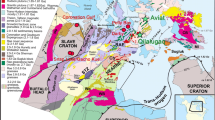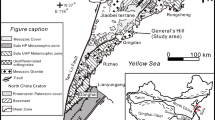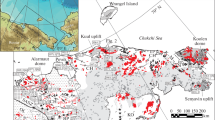Abstract.
Mafic rocks representative of the alkaline magmatism of the Alto Paranaíba Province in southwestern Minas Gerais, Brazil were studied by means of petrography, mineral, whole-rock and isotope geochemistry with the objective of better understanding this Cretaceous magmatism and the characteristics of the magma sources. Because of the variety and complexity of lithotypes examined in this research and the paucity of detailed studies of these Brazilian rocks in the literature, this study also attempts to establish parameters that allow for a clear distinction between kimberlite and kamafugite. Fifty-two occurrences are described and classified as kimberlite or kamafugite. Among the kamafugites, both ugandite (characterized by the presence of leucite) and mafurite (with kalsilite) end members have been characterized. Mineral compositions were found to be efficient in distinguishing between kimberlites, mafurites and ugandites in the province, primarily on the basis of phlogopite composition. The Re-Os isotope systematics permitted a better understanding of the relation of the sublithospheric mantle source to the magmatism in the region. Kimberlites, mafurites and ugandites have different 187Os/188Os ratios (0.117 to 0.129, 0.127 to 0.145 and 0.142 to 0.147, respectively). The Rb-Sr and Sm-Nd isotope systematics failed to indicate first-order differences between kamafugites and kimberlites, whilst 206Pb/204Pb ratios for the kimberlites are higher than those for the other rock types. Kimberlite and kamafugite isotopic compositions appear to be related to the mixture of at least two dominant mantle components: one with an isotopic signature similar to that of lithospheric peridotites, i.e., with 187Os/188Os ratios of the order of 0.118, similar to those observed in mantle-derived xenoliths entrained in kimberlites intruded in the Kaapvaal, Wyoming, and Siberian cratons; another with higher 187Os/188Os ratios of the order of 0.135, within the range of ratios reported for pyroxenite veins in alpine-type peridotites and ocean island basalts. Different melting depths of heterogeneous lithospheric sources by a mantle plume are suggested to explain the isotopic characteristics of the Alto Paranaíba Alkaline Province alkaline rocks.
Similar content being viewed by others
Author information
Authors and Affiliations
Additional information
Electronic Publication
Rights and permissions
About this article
Cite this article
Araujo, A., Carlson, R.W., Gaspar, J.C. et al. Petrology of kamafugites and kimberlites from the Alto Paranaíba Alkaline Province, Minas Gerais, Brazil. Contrib Mineral Petrol 142, 163–177 (2001). https://doi.org/10.1007/s004100100280
Received:
Accepted:
Issue Date:
DOI: https://doi.org/10.1007/s004100100280




